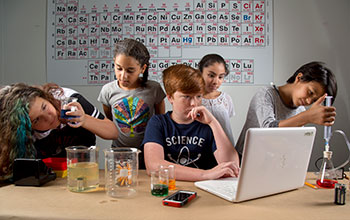Multimedia Gallery
Students performing experiments in the classroom
The STEM "spark" -- something that grabs young people's interest in science, technology, engineering and mathematics -- starts at an early age. From performing simple science experiments in a classroom, such as the students pictured here, to a greater moment of inspiration, such as viewing the first image of a black hole, the STEM spark is the moment a child becomes curious and wants to learn more about the world around them. Sparking scientific curiosity at a young age is important to prepare a diverse STEM workforce for our nation’s future.
Learn more in the NSF Director's Op-Ed Sparking scientific curiosity and recruiting talent for the benefit of our nation. (Date image taken: June 2016; date originally posted to NSF Multimedia Gallery: July 20, 2018)
Credit: Christina S. Murrey, College of Education, University of Texas at Austin
See other images like this on your iPhone or iPad download NSF Science Zone on the Apple App Store.
Images and other media in the National Science Foundation Multimedia Gallery are available for use in print and electronic material by NSF employees, members of the media, university staff, teachers and the general public. All media in the gallery are intended for personal, educational and nonprofit/non-commercial use only.
Images credited to the National Science Foundation, a federal agency, are in the public domain. The images were created by employees of the United States Government as part of their official duties or prepared by contractors as "works for hire" for NSF. You may freely use NSF-credited images and, at your discretion, credit NSF with a "Courtesy: National Science Foundation" notation.
Additional information about general usage can be found in Conditions.
Also Available:
Download the high-resolution JPG version of the image. (9.7 MB)
Use your mouse to right-click (Mac users may need to Ctrl-click) the link above and choose the option that will save the file or target to your computer.

